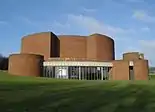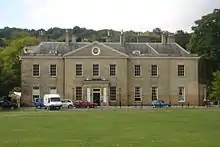Brunswick, Hove
Brunswick Town is an area in Hove, in the city of Brighton and Hove, England. It is best known for the Regency architecture of the Brunswick estate.



History
Originally, the area had been part of Wick Farm. Then in the late 18th and early 19th centuries, nearby Brighton had become very fashionable, especially amongst the top tier of British society. The Kemp Town estate there had been a success, and so in 1824 architect Charles Busby entered into an agreement to build houses on land lying at the extreme east of Hove, adjacent to Brighton — land which belonged to Thomas Read Kemp, creator of Kemp Town.[1] The name "Brunswick" was presumably taken from House of Brunswick, a term sometimes used for the House of Hanover, the name of the British royal family at the time.
Brunswick Town was built as a collaborative project between the architect C A Busby and the landowner Reverend Thomas Scutt (also a clergyman). Construction started in 1824. The first houses were completed by 1826. September in fact.[2]
Busby designed Brunswick Town as a long row of terraced houses facing the sea. In the middle point of this sea-facing terrace was a central square, which stretched back. This square was named Brunswick Square. The terraced houses, in Brunswick Terrace and in Brunswick Square, were built for the upper classes, they were designed as 'first class' housing. Beyond these houses were second classes houses in streets such as Waterloo Street.[1][2][3]
Facilities including a market were provided. The market, opened in 1828, was funded by Busby himself but was not a success and was converted to a riding school in the 1840s. It is now a theatre.
In the late 1990s the top of Brunswick Square, where it meets busy Western Road, was closed to motor traffic, changing the nature of the square from a through route to a strictly residential area.
At the extreme eastern edge of Brunswick Terrace, on the border of Hove and Brighton, the bluntly modernist Embassy Court apartment block was refurbished in the mid-2000s. When originally envisaged in the 1930s, this lone block was imagined as the beginning of a transformation of the entire seafront, which would have entailed the obliteration of Brunswick Terrace. By the late 1940s Brunswick Square itself had become so run-down that the Council was considering wholesale demolition and redevelopment with modern housing.

Notable residents
Brunswick Square and Brunswick Terrace have had a large number of prominent residents. These include:
- Henry Brougham, 1st Baron Brougham and Vaux
- James Brudenell, 7th Earl of Cardigan
- Roger Quilter, composer
- John Horace Round, historian
- Robin Maugham, writer
- Robert Bevan, artist
- Philip Salomons, financier, who built a Roof-top synagogue at 26 Brunswick Terrace
- Admiral Sir George Augustus Westphal, served in over 100 actions and wounded at Trafalgar on HMS Victory lived at No 2 Brunswick Square 1836-1875
- Sir Winston Churchill was schooled in Hove in the Brunswick area between 1883 and 1885. Read the article on My Brighton & Hove.
- Edward Carpenter, English socialist poet, socialist philosopher, anthologist, and early gay activist
- Nick Tyson, the curator of The Regency Town House. He is creating a Heritage Centre at 13 Brunswick Square.[1]
Politics
Brunswick is currently part of the local council's Brunswick & Adelaide ward which is represented by two Green councillors, Phélim Mac Cafferty and Hannah Clare. Phélim was first elected to the ward in May 2011 alongside former councillor Ollie Sykes, gaining it from the Liberal Democrats.
Culture

- The Brunswick Festival takes place each year, centred on Brunswick Square. http://www.brunswickfestival.org.uk
The Brunswick Festival Group is a voluntary organisation which produces this annual festival in celebration of the diverse community of Brunswick, Hove. Brunswick Festival is one of the longest running festivals in the city, and in 2016 will be celebrating its 35th birthday. Through the hard work and efforts of a small team of local residents and volunteers, this vibrant community Festival has grown over the years from being a low key family picnic on the green, and now encompasses two whole weekends of outdoor events.
- 13 Brunswick Square, formerly a private house, is used as a museum (the Regency Town House) demonstrating Regency life.
- The Old Market, built in 1828 to serve Brunswick Town, was restored in 1999 and is used as a theatre.
References
- Brunswick Town, by Judy Middleton, 2001.
- Binney, Marcus (1998). Town Houses - Evolution and Innovation in 800 years of Urban Domestic Architecture. Great Britain: Mitchell Beazley. pp. 94, 95, 96, 97. ISBN 1840000295.
- Bingham, Neil (1991). C.A. Busby: The Regency Architect of Brighton and Hove. London: RIBA Heinz Gallery. p. 46. ISBN 9781872911106.
External links
- Brunswick on My Brighton and Hove
- Regency Town House
- The Old Market — a history of the market and its later use as a riding school
- Brunswick Square and Terrace Residents' Association
- East Brunswick Residents' Association


.jpg.webp)


.jpg.webp)

